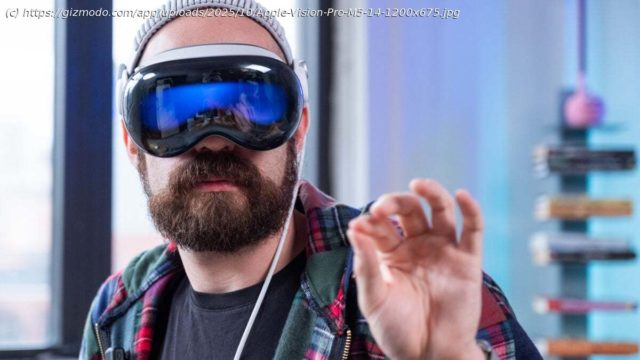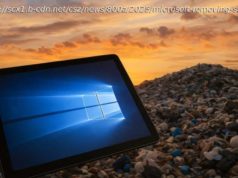The headset is faster, comfier, and better for gaming, but sorry, you’ll still look awkward.
I’m writing this review with an M5-powered Vision Pro on my head and my MacBook Pro on my lap. The MacBook’s screen is projected in front of me in an ultrawide format large enough that it swallows the entirety of the living room area inside of Gizmodo’s office. It’s a magnificent, novel sight for all of about 30 minutes. I can feel the headset bearing down on my face. The refreshed Vision Pro’s new Dual Knit band keeps some of the weight on my forehead, but I know I will need a break. Apple’s mixed reality headset is better than it was almost two years ago, and largely because of a better battery, peripheral support, and many, many software updates. And it’s still an expensive—and occasionally awkward—work in progress that may never truly reach Apple’s full ambitions.
The number of people who have never typed on a keyboard, never used a smartphone, and never used a laptop is dwindling. There are still so many people who have never tried any variety of VR (virtual reality), AR (augmented reality), or XR (extended reality) headset. Even fewer have put their eyes behind Apple’s $3,500 Vision Pro since it hit the scene back in February 2024. And that makes sense. Heavy headsets strapped to your noggin seem like the worst way to interact with our interconnected environment. Headsets will remain a peripheral built for the niche; made for those who enjoy odd tech and unique experiences. Still, the new Vision Pro with M5 chip is simply the most powerful, and most perfunctory, headset around.
You have to hand it to Apple. Any other company—Google, for instance—would have cut its losses unceremoniously by now. Hell, with Android XR and Samsung’s promised new ultra-expensive headset, there’s still time. Meta is still leading the pack in price for performance with the $500 Quest 3 and $300 Quest 3S, but it seems the Mark Zuckerberg-led company has also decided AR smart glasses are a better investment than any kind of computer for your face.
The update to Vision Pro feels, in many ways, like a consolation prize for those who stuck it out through all the launch hype, then the subsequent backlash, and finally the doldrums of the intervening months—when many regular consumers had nearly forgotten Apple’s first “spatial computer” even existed. To its credit, Apple has not abandoned Vision Pro. It has continued to update the headset with new 3D content. The problem is the number of apps built from the ground up for visionOS has slowed. I hope there will be an uptick in support with this new hardware update, but I’m not holding my breath. Now with support for third-party peripherals, there could be entire unexplored use cases. Paying for fake pickup pickleball shouldn’t be the main reason anybody will go out and drop $3,500 for the minimum 256GB of storage for a perfunctory, though still promising, spatial—no, let’s call it ”facial”—computer.Still heavy, even with a ‘Dual Knit’ band
The first upgrade you’ll notice from the M2 version is the new M5 model includes an option for a “Dual Knit” band. It comes with an extra strap that reaches across the top of your head. You still tighten it with a single knob, just like the previous single-band strap. With the new band, the headset’s weight rests more on the top of the head, toward the forehead. This takes some of the weight off your brow compared to the old strap system. It also makes you look like a true “dork,” as Gizmodo’s Senior Editor of Consumer Tech Raymond Wong was ready to lay at my feet as soon as he saw me wearing it.
I had previously relied on a third-party accessory by Annapro—an attachable band that helps distribute the weight toward my forehead. This strap also resulted in a worse seal around my eyes. There’s no perfect way to alleviate the pressure of such a thick and heavy headset made to rest over your eyes. Even if you can stomach the discomfort, you’ll inevitably need to take the headset off to cure any lingering eyestrain. You know what? That’s fine. It’s good to have a reason to take yourself away from the computer and touch grass, or else just get away from every screen constantly demanding your attention. Just remember to take the external battery out of your pocket when you get up, or else your $3,500 headset will go skittering across the ground.
This Vision Pro with M5 chip is still best enjoyed with passive content—whether that’s short spatial movies and documentaries available on the Apple TV app or 3D movies on the Disney+ app you’re keen to watch alone. Of course, me being me, I tried using the device for gaming. The twin 4K micro-OLED displays on the Vision Pro with M5 now support up to 120Hz refresh rates, compared to the M2 model, which could only refresh up to 100Hz. That means if you’re planning to use the Portal app for Xbox Game Pass or GeForce Now for game streaming, you can expect to see these games running smoother than before. As for games you can play natively in 2D—not in VR with depth—on Vision Pro, that’s expanding as well. Currently, Apple is promoting several titles including Sniper Elite 4 that are actually natively compatible with Vision Pro. Control, which is coming to several Apple products including iPad and Mac, will also run on the Vision Pro with M5 chip. The six-year-old game includes some ray tracing effects for better lighting, which Apple promises will be enabled once it’s available in 2026.
The new Vision Pro is still a strange device with odd, incongruous components that don’t make it any better. The EyeSight function, displayed on the low-quality external LCD screen, still requires any onlookers to peer very closely if they want to catch a hint of your irises. And the battery attachment will still turn off the device as soon as it’s disconnected, without any extra grace period.






